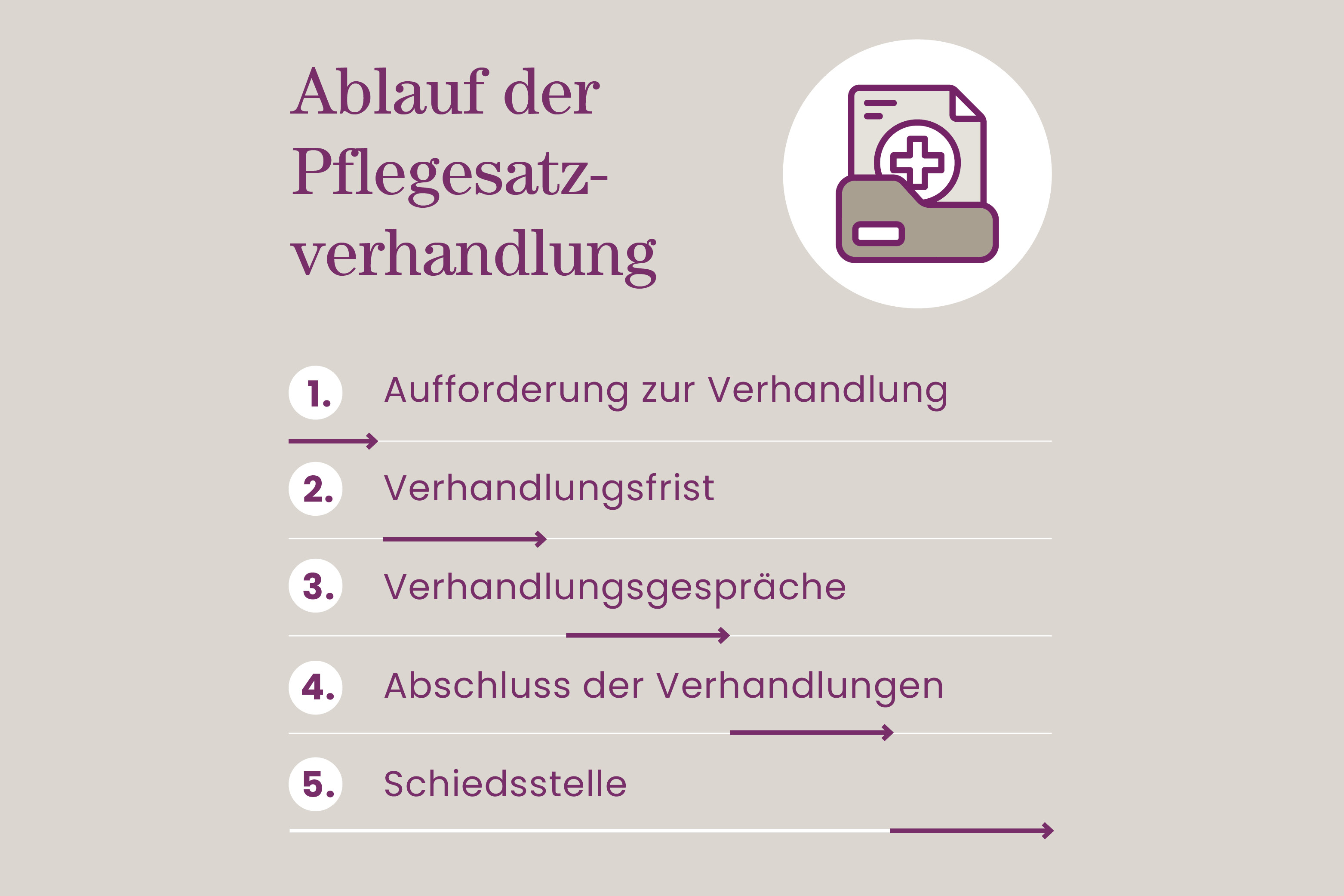Care rate negotiations are a central component of the care sector and are crucial for financial stability and quality assurance in care facilities.

Care rate negotiations: Preparation for success
These negotiations concern the determination of the remuneration rates that care facilities receive from care insurance funds and other payers for their services. Well-prepared care rate negotiations enable care organisations to agree appropriate care rates, which ensures the provision of the necessary resources for high-quality care.
Care rate negotiations are particularly important for care providers, as they form the economic basis for the operation and further development of the facility. Successful negotiations help to ensure that care facilities can cover the rising costs of staff, accommodation and catering, while at the same time enabling investment in the quality of care. This is particularly important in times when the demands on care facilities and staff are constantly increasing.
What are care rate negotiations?
Care rate negotiations are essentially contract negotiations between care facilities and care insurance funds as well as the local social welfare organisation. This involves agreeing the care rate – the amount of money that the funding organisations pay to the facility per day and per person in need of care. This care rate is made up of various components, including the costs of care and support as well as accommodation and meals. Negotiations usually take place annually and result in a care rate agreement that determines the level of remuneration for a specific period.
Why are care rate negotiations so important?
Nursing rate negotiations are of existential importance for care facilities. The negotiated care rate determines the financial situation of the care organisation. If the care rate is too low, costs may not be covered and the quality of care may suffer. An appropriate care rate, on the other hand, enables you to attract and retain qualified staff and offer your residents in day care or nursing homes the best possible care.
In short, successful care rate negotiations are the key to economic stability and ensuring the quality of care.
Understanding negotiation processes
Nursing rate negotiations in Germany are heavily dependent on the respective legal and structural requirements of the federal states. Each federal state has its own regulations and procedures that influence the negotiation processes. These differences affect both the level of care rates and the criteria on which the negotiations are based.
A care organisation in Bavaria could therefore be confronted with different requirements and framework conditions than a care organisation in North Rhine-Westphalia. For example, the requirements for staffing, material costs and quality assurance may vary. The way in which negotiations are conducted can also differ. Some federal states have stricter legal requirements, while others leave more room for manoeuvre for individual agreements.
It is therefore important for care companies to be familiar with the specific regulations and requirements of their federal state and to prepare themselves accordingly. A sound knowledge of the regional differences makes it possible to conduct negotiations in a targeted manner and achieve the best possible results.
Negotiations on care rates take place between two main parties: the care insurance funds and the care homes. Each of these parties has different interests and objectives that are incorporated into the negotiation process.
- Cost bearers: The cost bearers pay for the care services provided alongside those in need of care. Their main interest lies in keeping care costs within reasonable limits while ensuring a high quality of care. They are legally obliged to work economically and efficiently, which means that they endeavour to agree appropriate but also cost-effective care rates.
- Nursing homes: Nursing homes, as service providers, aim to receive fair and sufficient remuneration for their services. They must cover the rising costs of staff, accommodation, catering and operational risks while ensuring that the quality of care is not compromised. Care homes must defend their commercial interests and demonstrate that the proposed care rates are justified.
The negotiation process itself is often complex and requires thorough preparation and strategic planning. Care organisations must prepare detailed cost calculations that take into account all relevant expenses. These estimates serve as the basis for the negotiations and must be submitted to the cost bearers.
A successful negotiation process requires a deep understanding of one’s own operational cost structures as well as the legal and regulatory requirements. Care organisations must be able to present their calculations clearly and comprehensibly and justify the necessity of the proposed care rates.
LW·P Lüders Warneboldt supports care companies in successfully organising the negotiation processes with the cost bearers. With our extensive experience and interdisciplinary expertise, we help you to develop and implement your negotiation strategy in order to achieve the best possible care rate agreements.
We are familiar with the differences between the federal states and the interests of the parties involved and can provide you with targeted support in your negotiations. Rely on our expertise to successfully position your care facility and optimise the remuneration of your care services.
How often do care rate negotiations take place?
As a rule, care rate negotiations take place annually. This is not required by law, but is strongly recommended. The reason for this is the dynamic development of costs. Staff and material costs can change significantly over the course of a year, as can the framework conditions of care insurance. It therefore makes sense to adjust the care rates regularly to ensure that they reflect the actual costs of care operations.
However, there are also exceptions to this rule. For example, unscheduled negotiations can also take place in the event of significant changes to the cost structure. Initial negotiations are also necessary when opening a new care facility in order to determine the initial care rate.
Preparation for care rate negotiations
Thorough preparation is the key to success. It enables your care organisation to present well-founded arguments and represent your interests effectively. Here are the most important steps for preparation as well as a practical checklist for care providers.
Important steps for preparation:
- Record all relevant cost factors (personnel, material costs).
- Analyse your occupancy figures and capacity utilisation.
- Compare your data with that of the previous year to recognise trends.
- Document the services you have provided in detail.
- Identify areas in which you can demonstrate particular quality or efficiency.
- Find out about the care rates of comparable facilities in your region.
- Observe general trends and developments in the care sector.
- Keep up to date with legal changes.
- Consider political developments that could have an impact on the care sector.
- Define clear objectives for the negotiations.
- Develop various scenarios and negotiation strategies.
- Put together a competent negotiating team.
- Ensure a clear division of tasks and communication structures.
LW·P Lüders Warneboldt supports care organisations with comprehensive preparation for care rate negotiations. Contact us for personalised advice on preparing your negotiations.

Calculation for care rate negotiations
Calculating care rates is a crucial step in preparing for care rate negotiations. In order to ensure an accurate and fair assessment of costs, care facilities must take into account various factors and influencing variables that can directly affect the level of care rates.
Important factors and influencing variables
- Staff costs: Staff costs generally represent the largest proportion of costs in care facilities. They include salaries, social security contributions and training costs for nursing staff. Changes in collective labour agreements or statutory adjustments to social security contributions can have a significant impact on personnel costs and must be taken into account in the calculation.
- Operating costs: Operating costs include all expenses incurred for the ongoing maintenance and operation of the care facility, such as energy costs, rent, insurance and maintenance costs. Fluctuations in energy prices or changes in rental conditions can significantly change the operating costs.
- Care quality and standards: Meeting or exceeding quality standards and legal requirements can result in additional costs. High-quality care services that require special qualifications or equipment must be adequately reflected in the calculation in order to ensure appropriate remuneration.
- Regional factors: The geographical location of the facility also plays a role. In regions with a higher cost of living, such as urban areas, the costs for staff and operation may be higher than in rural areas.
- Occupancy rate and care level of residents: The occupancy rate and the distribution of care levels of residents influence the income and cost structure of a facility. A high proportion of residents with higher care levels can mean higher income, but also requires more intensive and costly care services.
These factors must be carefully analysed and taken into account when calculating care rates in order to create a sound basis for negotiation with cost bearers. A comprehensive and transparent presentation of these influencing factors enables care facilities to communicate their financial requirements effectively and secure the necessary funding to guarantee high-quality care.
The care rate negotiation process
Care rate negotiations follow a structured process that is regulated by law and generally comprises the following steps:
- Request to negotiate: One of the contracting parties, usually the care facility, sends a written request to the funding organisations to negotiate.
- Negotiation period: After receiving the request, both parties have six weeks to reach an agreement. During this time, the negotiation dates are agreed and the respective positions are exchanged.
- Negotiation meetings: The negotiations usually take place in several rounds. The individual cost items are discussed in detail and attempts are made to find compromises.
- Conclusion of the negotiations: If an agreement is reached within the deadline, a care rate agreement is concluded, which sets the amount of the care rate for a certain period of time.
- Arbitration board: If no agreement is reached within the six weeks, either party can appeal to the arbitration board. This then makes a binding decision on the care rate.
Special features of the process
The exact procedure for negotiating care rates can vary depending on the federal state and care insurance fund. So-called framework agreements may also apply, which stipulate certain regulations for the negotiations.

Tips and strategies for successful care rate negotiations
Being successful in care rate negotiations requires a combination of thorough preparation, strategic thinking and skilful communication. Here are some proven tips and strategies that can help you achieve your goals:
- Transparency and comprehensibility: a detailed and comprehensible calculation is the basis for a successful negotiation.
- Focus on quality: Emphasise the quality of your care services and back them up with concrete evidence. Show how your services contribute to improving residents’ quality of life.
- Economic sustainability: Make it clear that an appropriate care rate is a prerequisite for economically sustainable management. Explain how a fair care rate enables you to invest in qualified staff, modern equipment and innovative care concepts.
- Expert support: Get support from experts if required. An experienced consultant can help you to strengthen your negotiating position, present your arguments convincingly and avoid pitfalls.
- Prepare in good time: Start preparing for the negotiations early on. The better prepared you are, the more confident and confident you will appear.
- Documentation: Record all negotiation results carefully. This will enable you to see what agreements were made afterwards.
LW·P Lüders Warneboldt supports you in preparing your negotiations optimally and conducting them successfully. Let our experts support you in your negotiations.

Conclusion
Negotiating care rates is a complex and challenging process that is crucial to the economic success and quality of care in your organisation. Thorough preparation, sound calculations and a strategic approach are the keys to success.


